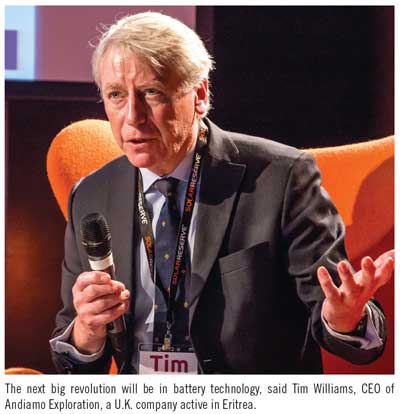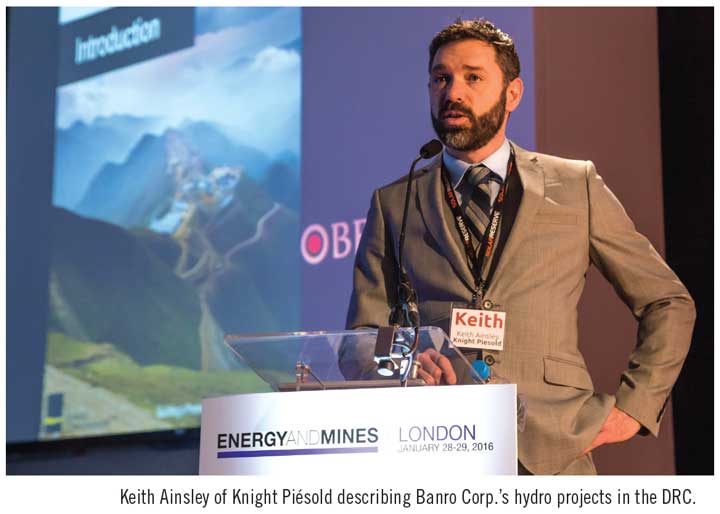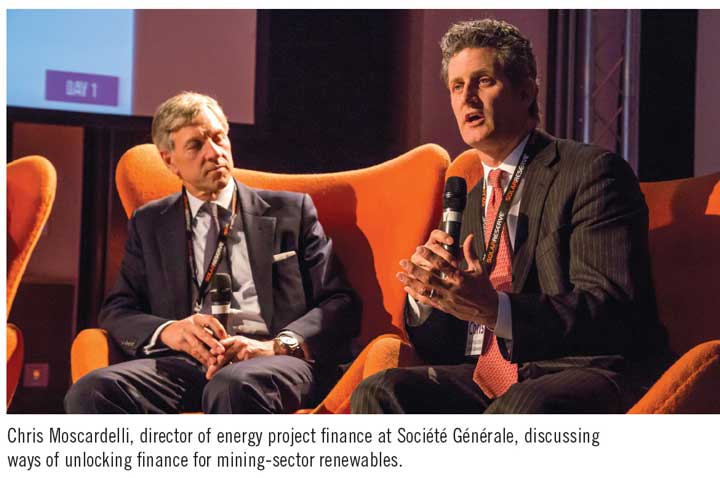Cutting energy costs is critical for mining companies. Simon Walker reports on views presented at the recent London conference on the role of renewables.
Vicente Gutierrez, vice president of CONFEDEM (Confederación Nacional Empresarios de la Minería y Metalúrgica) in Spain, speaks during one of the panel discussions.
Ottawa, Ontario-based Energy and Mines hosted the seventh in its series of “summits” in London at the end of January. Entitled Renewables for Mines: Driving competitive, secure and low-carbon power solutions for mines, the event attracted around 180 registrants from mining companies, energy suppliers, consultants, the finance sector, commodity traders and governments.

Opening the meeting, the chairman, and director of Mines and Energy, Adrienne Baker, stated her belief that renewables for mining will be a $5 billion market within the next five years, despite the current low oil price. “There is strong interest, with renewables capable of providing both cost savings and energy security,” she said.
In his welcome address, U.K. government Minister Tobias Ellwood pointed out that the mining sector is today facing the most difficult situation ever, with energy accounting for up to 40% of a mine’s operating costs. “The industry needs energy that is both stable and reliable,” he said. “The question is how to adapt businesses to use renewable sources, in terms of both financing and technology.
Looking specifically at one country with a vitally important mining sector, Ellwood pointed out that Morocco (which is hosting the COP22 climate-change conference in November) is becoming the “renewables powerhouse” for the region. Expanding on this, the secretary general of the Moroccan Ministry of Energy, Mines, Water and the Environment, Abderrahim El Hafidi, explained that whereas the country took just 2% of its energy from renewables in 2002, this proportion reached 12% last year with ambitious plans to achieve 52% renewable energy input by 2030. The state phosphate-mining company, OCP, is taking a leading role adopting renewables in its energy mix, he said.
Discussion Panels for Expert Insights
The meeting brought together two threads: conventional presentations relating to projects and technology with discussion panels featuring participants offering a range of expert opinion and experience. In the first such panel, focusing on strategic energy choices for mines, Tim Williams, CEO of Andiamo Resources, reminded the audience that the mining industry not only produces energy commodities in the form of coal and uranium, but also the materials needed for renewables technologies. “Right now, energy is priced very low, with substantial amounts of both oil and coal being produced at less than marginal cost,” he said.
“Costs will have to revert,” he went on. “Mines are wasting assets, most are short-lived, and with falling grades, the amount of energy needed to recover metals is rising rapidly.”
His thoughts were echoed by Maciej Majchrowicz, from KGHM in Poland. “Our mines are getting deeper, with longer haulages,” he said. “All this means more stress on our energy costs, with KGHM having already been faced with cuts to its energy supply from the national grid. The company is looking at ways of becoming more self-reliant for its energy needs, although it is clear that for systems such as wind power—and Poland has a lot of potential for this—energy storage is really important.”
Williams agreed. “The next big revolution with be in batteries,” he predicted, but went on to warn: “Mining companies need to understand what business they are in. They produce materials, and use energy. If they need to produce their own energy to stay in business, that is a different situation from being connected to a grid.
“Renewables have to be price-competitive, and subsidies will have to end eventually,” he said.
 Integrating Renewables
Integrating Renewables
The first three formal presentations focused on integrating renewable energy sources into a mine’s grid-based or stand-alone power supply. From consultant firm Knight Piésold, Keith Ainsley described how the company has been working with Banro Corp. since 2005 at its gold mining operations in the eastern Democratic Republic of Congo (DRC). He explained that, faced with diesel costs that remain high because of delivery charges to remote sites, Banro has been evaluating ways of incorporating hydrogeneration systems, with the aim of achieving $5 million in annual cost savings.
The 6.5-megawatt Ulindi 1 hydroelectric plant, carrying a $40 million price tag, will supply Banro’s Twangiza mine, while the $24 million Magembe plant, which involves rehabilitating an existing historical facility, will feed power to the Namoya operation, 180 km to the southwest. Banro elected to have two smaller plants rather than one big one for both lower capex requirements and better risk control. Payback periods are 2 and 3.3 years, respectively, Ainsley said.
An important feature of the project is that the plants will also provide power to local communities while the mines are working, and will then be handed over to the national power utility. Banro is now looking for strategic partners to help build and operate the two stations.
Moving continents, Romain Desrousseaux from the French IPP, Neoen, described how it has developed a hybrid solar-with-storage power-supply system for Sandfire Resources’ remote DeGrussa copper mine in Western Australia. The largest of its kind in the world, the system includes a 10.6-MWp photovoltaic (PV) facility covering 20 ha, and 4 MW (6 MWp) of lithium-ion battery storage, integrated into the mine’s 19 MW of diesel generating capacity.
Benefits for Sandfire include cheaper electricity, especially in the long term, no more volatility in electricity prices, better electricity quality, no capex (since the plant is provided by Neoen), and 5 million liters of diesel savings a year, Desrousseaux claimed. Construction began last July, with commissioning scheduled for March.

During the day, 80% of the mine’s 12-MW demand will come from the PVs, with diesel generation powering the operation at night. The battery capacity is used as a spinning reserve, rather than for load leveling. Desrousseaux admitted there are a number of challenges, including adapting to the health and safety requirements of the mining sector, and integrating the various sources of power supply. In addition, PVs cannot handle sudden changes in demand; hence the need for battery storage. Costs for a stand-alone off-grid system will be higher than those for government-supported projects, so mining companies have to have a long-term commitment, and the motivation, to achieve the biggest benefits from using an on-site IPP company.
Lastly in this session, Duncan Stevens from Gold Fields in South Africa reported on the company’s two-year evaluation of the potential for solar power to supplement its needs at the South Deep mine. With a life of more than 70 years, South Deep has an average demand of 55 MW, peaking at 75 MW, with energy accounting for 13% of its operating costs. Stevens explained that Gold Fields is aiming for at least 20% renewables at each new mine in its portfolio, with the company focusing on optimized, rather than maximized, solar input at South Deep.
Gold Fields has been working on its renewables projects with the Denver-based Carbon War Room-Rocky Mountain Institute. The organization’s CEO, Jules Kortenhorst, described its involvement, with its “Sunshine for Mines” project aiming to have 15% of the mining industry’s power needs run from renewables by 2025.
Gold Fields is now looking at a 40-MW photovoltaic plant for South Deep, with its initial request for expressions of interest having generated around 75 responses.
A request for proposals resulted in 28 responses, with 10 companies then submitting bids. As Stevens noted, some of those proposals claim to meet Eskom price parity today, and most trend favorably with inflation over the term of the prospective power purchase agreement. Energy storage technologies also appear to be on par with the current cost of diesel generation, he added.
Economics Stack Up
The message throughout the meeting was consistent: “Oil may be cheap now, but price volatility is inevitable. Renewables offer better long-term stability.” The challenge is to convince a traditionally conservative industry to take the next step, and to develop new mechanisms for financing renewable energy supply systems.
From the German solar power developer, Belectric, Nir Dekel described a conceptual hybrid solar-storage-diesel system for use at a southern African open-pit gold mine. With capex of $29 million, this could offer $1.7 million in annual energy savings, he suggested, with fixed power supply costs of $0.26/kWh for 24% solar input compared to $0.31/kWh for the 76% provided by diesel gensets. What is more, the entire solar system could be relocated to another site should the mine life be shorter than that of the PV panels.
However, it is not just solar energy that has potential for powering mines. As Jennie Thomas, environmental services manager at ICL’s Boulby potash mine in England, explained, the company has been evaluating a range of possibilities for offsetting its energy bills, especially in its ore-treatment plant.
These have included geothermal, heat recovery from the mine ventilation exhaust and brines, hydropower using the shafts, and wind turbines.
There is no question that renewables will play an increasing role in supplying mine energy requirements. However, noted ICMM’s CEO, Tom Butler, during a panel discussion, there is still plenty of unpredictability. “Funding is neutral on power plants, with money going to where returns are good and the risk is least,” he said.
“We are at the early stages of an energy transition,” added Matthew Bateson from Rio Tinto. “The future will be exciting for people who enjoy technical challenges.”










